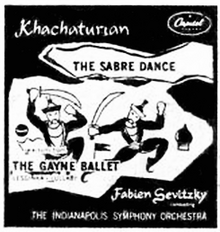
"Sabre Dance"[a] is a movement in the final act of Aram Khachaturian's ballet Gayane (1942), where the dancers display their skill with sabres.[2] It is Khachaturian's best known and most recognizable work worldwide.[3][4] In the composer’s own words, the “Dance of the Kurds”, which subsequently became the “Sabre Dance”, originated with the insistence of the Director of the Kirov Theatre already after the rehearsal process had commenced. Although Khachaturian considered the score to be complete, he reluctantly agreed to add another dance in the last act.[5][6][7]
"Sabre Dance" is considered one of the signature pieces of 20th-century popular music.[8] It was popularized by covers by pop artists,[9] first in the U.S. in 1948 and later elsewhere. Its use in a wide range in films and television over the decades have significantly contributed to its renown.[10] "Sabre Dance" has also been used by a number of figure skaters from at least five countries in their performances.
- ^ "Classical Selections of EP Singles ...". Billboard. August 29, 1953. p. 29.
- ^ Cite error: The named reference
atlantasymphonywas invoked but never defined (see the help page). - ^ Frolova-Walker, Marina (Summer 1998). ""National in Form, Socialist in Content": Musical Nation-Building in the Soviet Republics". Journal of the American Musicological Society. 51 (2). University of California Press on behalf of the American Musicological Society: 362. doi:10.2307/831980. JSTOR 831980.
... Khachaturian's most popular piece, the Sabre Dance ...
- ^ Robinson, Harlow (2013). "The Caucasian Connection: National Identity in the Ballets of Aram Khachaturian". In Kanet, Roger E. (ed.). Identities, Nations and Politics After Communism. Routledge. p. 23. ISBN 9781317968665.
...particularly the "Sabre Dance," which became the single most recognized piece of Khachaturian...
- ^ Shakarian, Pietro A. (8 November 2017). "Top Ten Origins: Russia's Relations with the Kurds | Origins". origins.osu.edu. Ohio State University. Archived from the original on 23 September 2023.
- ^ Helper, Allegra; Wasatch, Juanita (April 16, 2002). "Facets Model Assignment: "Sabre Dance"". Weber State University. Archived from the original on 18 July 2023.
- ^ "Aram Khachaturian - "Sabre Dance" from Gaiane". Sofia Philharmonic Orchestra. Archived from the original on 3 March 2024.
- ^ Adalian, Rouben Paul (2010). Historical Dictionary of Armenia. Lanham, Maryland: Scarecrow Press. p. 381. ISBN 978-0-8108-7450-3.
- ^ Staines, Joe (2010). The Rough Guide to Classical Music. Penguin. ISBN 9781405383219.
Filled with a sparkling array of folk-inspired tunes, its most famous episode, the manic "Sabre Dance", has had a life of its own, even materializing as a pop single.
- ^ "Khachaturian: "Sabre Dance" from Gayaneh". University of North Georgia Department of Music. 15 October 2013. Archived from the original on 11 June 2016.
Cite error: There are <ref group=lower-alpha> tags or {{efn}} templates on this page, but the references will not show without a {{reflist|group=lower-alpha}} template or {{notelist}} template (see the help page).
